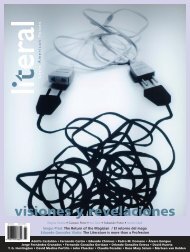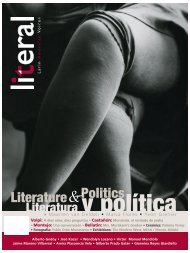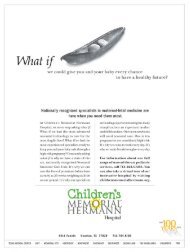Giobany Arévalo > Gabriela Torres Olivares >Anuar Jalife - Literal
Giobany Arévalo > Gabriela Torres Olivares >Anuar Jalife - Literal
Giobany Arévalo > Gabriela Torres Olivares >Anuar Jalife - Literal
Create successful ePaper yourself
Turn your PDF publications into a flip-book with our unique Google optimized e-Paper software.
LIBROS BOOKS CD RECORDS<br />
ALMOST IDEOGRAMATIC<br />
Brandon G. Holmquest<br />
Alejandro Zambra<br />
Bonsai,<br />
Malville House,<br />
Brooklyn, NY, 2009.<br />
Translated<br />
by Carolina de Robertis<br />
A deceptively clever novella that seeks, on<br />
every level, to mimic the form of the titular<br />
tree, Alejandro Zambra’s Bonsai fi rst presents<br />
itself as a simple boy-meets-girl story. What<br />
follows is a series of narrative and formal<br />
contortions which deviate pleasantly from<br />
anything the boy-meets-girl set up might<br />
reasonably imply. Zambra likewise winds his<br />
way over, above and around what might be<br />
expected from a more or less self-conciously<br />
literary (the boy and girl lie to one another<br />
about having read Proust), meta-fi ctional<br />
(the book’s fi rst line gives away the ending),<br />
contemporary (there’s a fair amount of sex,<br />
drugs and mortality) novella by Chilean (you<br />
know who). The book is indeed inventive,<br />
though not merely. The literary acrobatics<br />
are decidely in the service of the story, or, to<br />
put it another way, the form is never more<br />
than an extension of content. And vice versa.<br />
What’s impressive is that the entire thing is<br />
welded to the idea and image of a bonsai<br />
in way that is almost ideogramatic. Zambra<br />
wrote in the Colombian journal piedepágina<br />
that the book’s origin was fi rst suggested by<br />
a newspaper “photograph of a tree covered<br />
in a transparent fabric,” part of Christo and<br />
Jeanne Claude’s Wrapped Trees series. This<br />
set him off on the usual stumbling path towards<br />
something. The fi nal result is a very<br />
short book that is nearly an exact analogue<br />
for that “transparent fabric.” The translation<br />
by Carolina de Robertis, who has a novel of<br />
her own coming out later this year, is high<br />
quality. She performs particularly impressive<br />
acrobatics in a tricky passage early on where<br />
fi ve different terms for the sexual act are humorously<br />
contrasted with some supposed<br />
national characteristics thrown in. This sort of<br />
thing can be very diffi cult to capture at all, and<br />
often is lost on English-readers who lack the<br />
cultural details common to Latin Americans.<br />
De Robertis just mows it down and makes it<br />
look rather easy. Bonsai is a shockingly quick<br />
read at an infl ated 83 pages and is satisfying<br />
for that very reason. You consume it whole.<br />
Zambra’s last couple of books, including this<br />
one, have been published by Anagrama,<br />
which is basically Spanish for “New Directions,”<br />
so I think we all might want to keep<br />
an eye on him from now on.<br />
AIDS HOSPICE<br />
David D. Medina<br />
Mario Bellatin<br />
Beauty Salon,<br />
City Lights,<br />
San Francisco, 2009.<br />
Translated<br />
by Kurt Hollander<br />
Mexican writer Mario Bellatín has created a rare<br />
literary feat: in just 63 pages he has produced<br />
a novella that sparkles with beauty and clarity<br />
as it delves into one of the most horrifying and<br />
shunned diseases of our times–AIDS.<br />
In Beauty Salon, the narrator is a transvestite<br />
hairdresser who has converted his<br />
business into a makeshift AIDS hospice. He<br />
runs the place by himself, and with a sense<br />
of morbid humor, he calls it the Terminal because<br />
he takes in only men who are about to<br />
die and cannot fi nd anyone to care for them.<br />
The nameless narrator operates the Terminal<br />
with strict rules and does not allow doctors,<br />
medicine, herbal remedies, or religious<br />
icons. Women are also not welcomed. When<br />
his place was a beauty salon, the narrator<br />
explains, he spent a lot of time making the<br />
women beautiful and he does not want to<br />
see his work go to waste.<br />
When he operated the salon, the narrator<br />
got the idea of installing aquariums to<br />
make the women feel as if “they were submerged<br />
in crystal clear water, rejuvenated<br />
and beautiful…” He became a fi sh collector,<br />
buying an assortment of fi sh that gave him<br />
pleasure as he watched their colorful bodies<br />
streak through the water. But as death enters<br />
the salon, the fi sh perish.<br />
Bellatin © Mastrangelo Reino<br />
The freshness of the aquariums is a<br />
sharp contrast to the dreary existence of the<br />
Terminal, but they also serve as a metaphor<br />
for the way people view AIDS victims. People<br />
see fi sh through a glass container, from a distance,<br />
and when one of them dies, they are<br />
scooped up and fl ushed down the toilet. In<br />
the story, AIDS victims are buried in a paupers’<br />
grave without a ceremony.<br />
In an unemotional fashion, the narrator<br />
tells his story about his sexual exploits as a<br />
transvestite, his experiences in bathhouses<br />
and his downfall from a deadly disease. He<br />
tells a poignant story about becoming affectionate<br />
with one of the patients, whom he<br />
calls “guests,” only to see the young man die<br />
later. Thereafter, the narrator decided never<br />
to become attached to his guests. The narrator<br />
is so resigned to his lot that he appears<br />
saintly as he goes about helping the AIDS victims<br />
die a humane death.<br />
AIDS is never mentioned in the book;<br />
it is referred to only as “the disease.” Also,<br />
the location of the story remains vague and<br />
the characters remain nameless, anonymous<br />
in an uncaring world. As in the book, many<br />
people in the real world still believe that AIDS<br />
victims have brought about their own misfortune<br />
and deserve to be punished.<br />
Written in simple sentences that fl ow effortlessly<br />
without the interruptions of chapters,<br />
Beauty Salon is a lyrical piece about how<br />
a disease is turning its victims into pariahs, and<br />
as a result has made our society less human.<br />
Mario Bellatín had the courage to write<br />
about this taboo in a country that is known<br />
for its homophobia, and in return he was rewarded<br />
with a little book of deep beauty.<br />
OTOÑO, 2009 LITERAL. VOCES LATINOAMERICANAS 53






